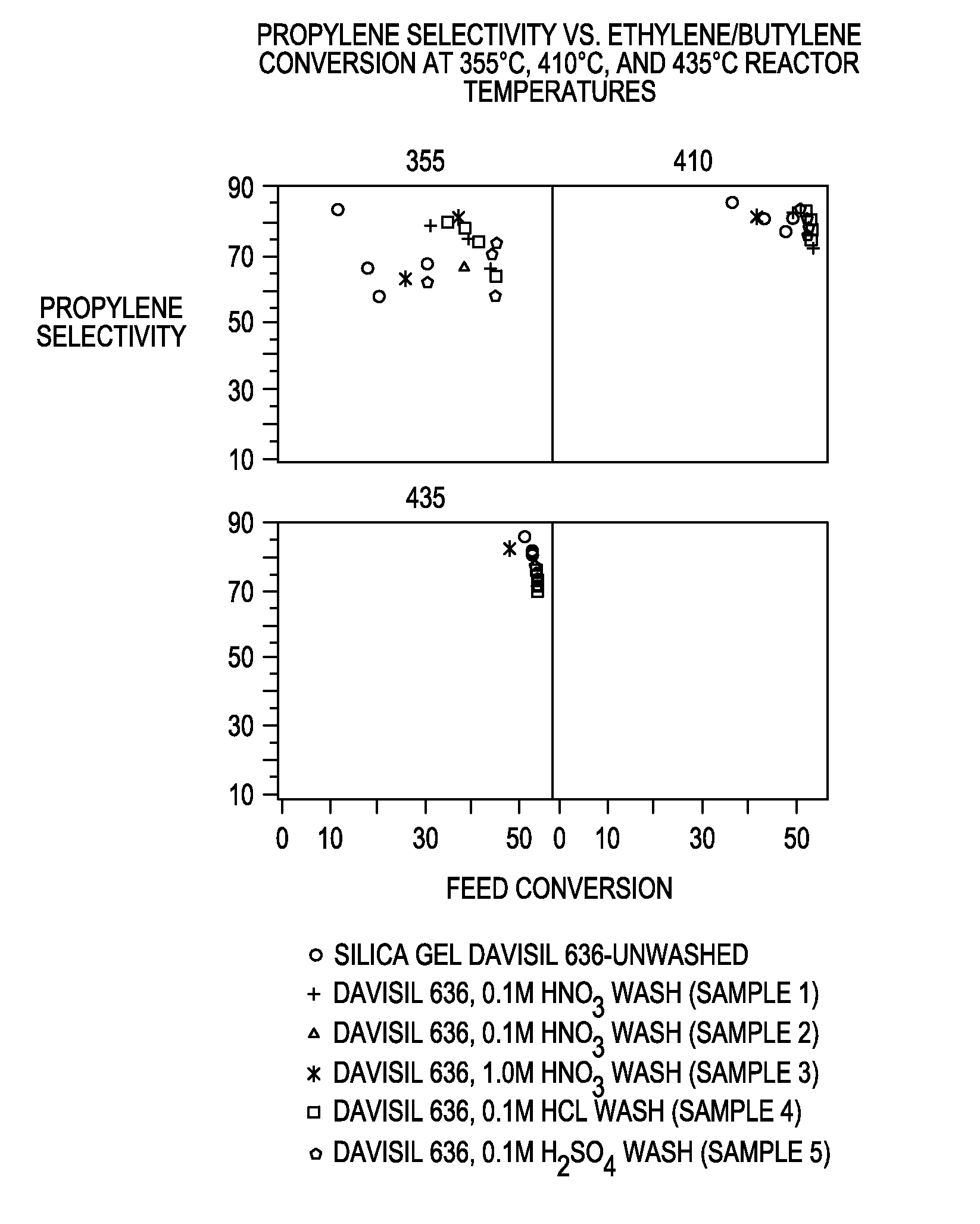Acid Washed Silica Supported Catalysts and Their Use in Olefin Metathesis
a catalyst and catalyst technology, applied in the field of acid washed silica supported catalysts and their use in the metathesis of olefins, can solve the problems of steam cracking, insufficient propylene to satisfy the worldwide demand, and complex combination of reaction and gas recovery systems, so as to reduce the overall acidity of the support, improve the activity of the resulting catalyst, and significantly compromise the selectivity
- Summary
- Abstract
- Description
- Claims
- Application Information
AI Technical Summary
Benefits of technology
Problems solved by technology
Method used
Image
Examples
example 1
Acid Washing of Silica Supports
[0035]A 20 gram sample of Davisil®636 (VF) (W.R. Grace & Co., Columbia, Md.) silica powder was mixed with 200 grams of water. Concentrated nitric acid was added to the mixture dropwise over 1 minute to achieve a target acid concentration of 0.1 M. After the acid addition, the mixture was heated to 85° C. (185° F.) for 1 hour and then vacuum filtered. The filter cake was washed with 200 grams of water and dried overnight at 120° C. (248° F.) in an oven and under an air purge. These steps were then repeated two more times to obtain the acid washed silica support (sample 1).
[0036]Additional acid washed silica supports were obtained by repeating the acid washing procedure with 0.1 M target HNO3 concentration (sample 2), and also acid washing with 1.0 M target HNO3 (sample 3), 0.1 M target HCl (sample 4), and 0.1 M target H2SO4 (sample 5). Sample 2, however, unlike samples 1 and 3-5, was not subjected to the final drying step but instead calcined at 500° C....
example 2
Tungsten Impregnation of Acid Washed Silica Supports and Calcination
[0038]Each of the acid washed silica supports prepared in Example 1, sized to 35-60 US mesh (0.25-0.5 mm), was impregnated with tungsten at a targeted tungsten metal content of 6% based on the total dry catalyst weight. The supports were weighed into 12 crucibles using about 1-2 ml per crucible well. Weighing was performed either manually or otherwise using an automated powder dispensing system. The tungsten was added, in the form of an ammonium metatungstate solution, to separate empty crucibles. Liquid reagent was pipetted and diluted with deionized water, to obtain about a 2:1 solution to silica ratio, using the Zinsser Lissy® GXL liquid handling system. The solids were then added to the corresponding liquids. The resulting mixtures were placed on a vortexer for 10 minutes and then rotary dried under 2 psig flowing nitrogen at 120° C. (248° F.) for 1-2 hours, until free flowing. The dried, tungsten impregnated, a...
example 3
Comparative
[0039]Preparation of Reference Catalyst with Unwashed Silica Support
[0040]A reference WO3 catalyst sample was prepared using the tungsten impregnation procedures described in Example 2, but with a Davisil®636 silica support that had not been acid washed according to Example 1.
PUM
| Property | Measurement | Unit |
|---|---|---|
| Temperature | aaaaa | aaaaa |
| Temperature | aaaaa | aaaaa |
| Fraction | aaaaa | aaaaa |
Abstract
Description
Claims
Application Information
 Login to View More
Login to View More - R&D
- Intellectual Property
- Life Sciences
- Materials
- Tech Scout
- Unparalleled Data Quality
- Higher Quality Content
- 60% Fewer Hallucinations
Browse by: Latest US Patents, China's latest patents, Technical Efficacy Thesaurus, Application Domain, Technology Topic, Popular Technical Reports.
© 2025 PatSnap. All rights reserved.Legal|Privacy policy|Modern Slavery Act Transparency Statement|Sitemap|About US| Contact US: help@patsnap.com

